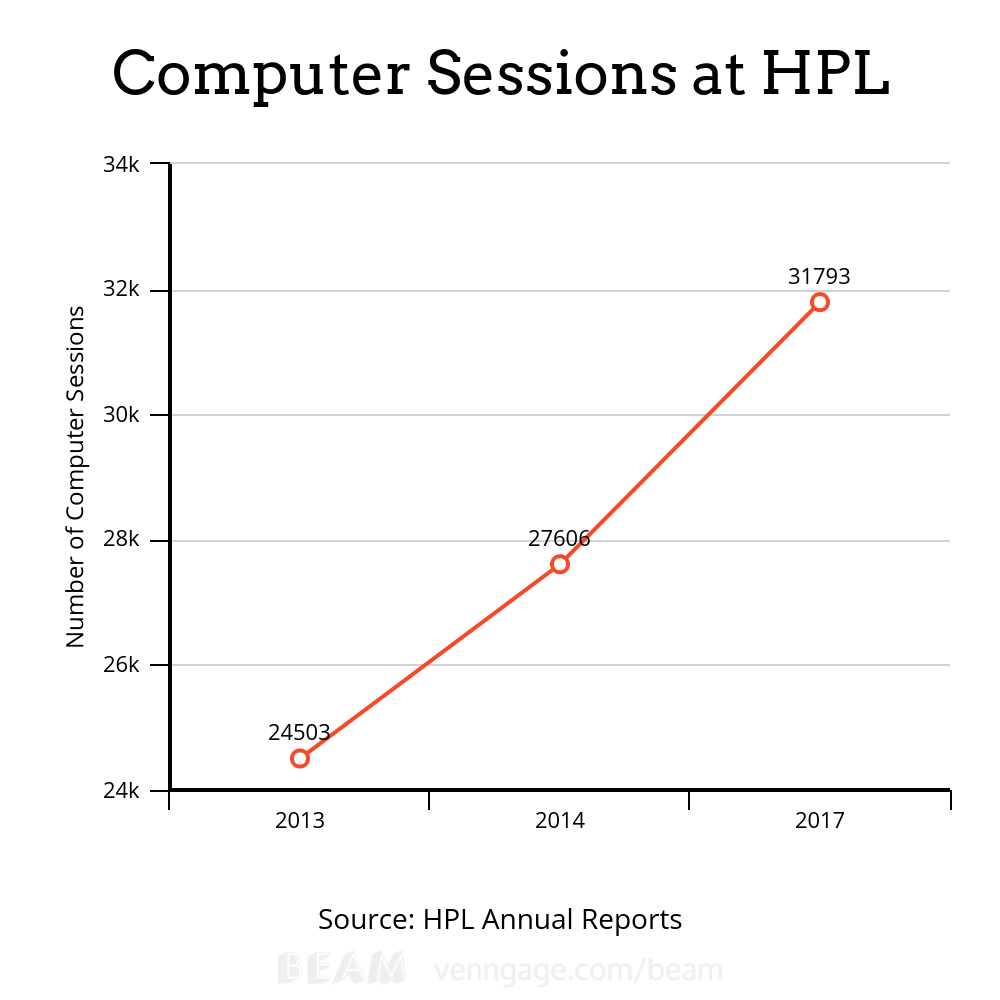By Marissa Davis
An unassuming brick building lies in the shadows of Town Hall on Dixwell Avenue. Weeds grow from sidewalk cracks. Construction noise provides a background soundtrack. Inside the building, books — yes, books still exist — fill wooden shelves as people loiter with an unspoken to read a newspaper or assemble a puzzle. Children entertain themselves with toys and books while surrounded by brightly painted animals.

Photo by Marissa Davis
That’s a typical scene in the Miller Memorial Library in Hamden, Connecticut. It’s the main branch of the three libraries in a town of 61,000 people.
The library is named in honor of inventor and businessman, Willis E. Miller. Miller died in 1904 and his widow bequeathed the library to the town. It originally opened its doors in 1952, but has been renovated several times since.
The HPL is centered upon the Miller Memorial Library and two other branches. The two branches are the Brundage Community Branch on Circular Avenue and the Whitneyville Branch on Carleton Street.
But that centerpiece library named in honor of Miller is falling apart according to library officials.
“I’ve been here for seven years and so when I got here I had to take stock of the physical condition of the library,” library director Marian Amodeo said. “Technically we should have a new building.”
Annual reports in 2013 and 2014 point to the main library’s deterioration and problems with the branch libraries.
In 2013, the report noted issues with the phone system and spotty Wi-Fi service.

Photo by Marissa Davis
The 2014 annual report is apocalyptic.
“The exteriors of all three Hamden library buildings are in dire need of repair and attention,” the report stated. “The branch libraries need paint and other repairs to the buildings, and the grounds are an embarrassment. The main library needs power-washing of the bricks, landscaping and other repairs.”
The report revealed that the Miller Library lacked working fire alarms.
The 2017 report furnished equally bad news.
“The poor condition of the buildings and the grounds of both branches is stunning,” the report stated. “Painting, both interior and exterior, landscaping, cleaning, ceiling tile replacement, lighting, carpeting, furniture replacement, driveway and parking lot resurfacing, security and more is needed at both locations.”
The most recent annual report speaks to frustrations with the lack of movement in implementing repairs to both buildings.
Even with its structural challenges, the HPL continues to operate and produce programs for children and families.
“We moved every single thing around in the library in order to make a larger space for the children’s department,” Amodeo said. “This is a town of 60,000 people and the space allotted for children was minuscule so we just tripled the size of the children’s room and made an early learning center.”

Photo by Marissa Davis
Every kindergartner and fourth-grader living in Hamden visit the library for a story-based program and library cards. And the HPL now runs the Hamden Public Schools’ summer reading program.

HPL offers numerous free programs families, according to Marcy Goldman, head of Children’s Services.
“Throughout the year, September through May, we have weekly story time sessions,” Goldman said. “They run for five weeks at a time we do different age groups so that they’re age appropriate and we can incorporate what we are supposed to incorporate into a story time.”
But the library offers more than just story time for children.
“We also have STEM play for preschoolers, so I have lots of different things I buy from Lakeshore that are STEM-related but they’re good for young kids,” Goldman said. “So one of them for instance is a fairy-tale kit. So it’s the three little pigs and they have to practice with the sticks and the blocks that they give them, building the house that’s gonna be the strongest.”
HPL also offers convenient activities for the transient families that reside in Hamden.
“We have playgroups too that are just very casual,” Goldman said. “A lot of parents like that, there’s a lot of people in this community that come to the library that are new to town. We find that there’s a lot of transient people, they come here because their husband or wife is doing their residency at Yale, so they live here for that amount of time and then they move. Those people use the library a lot.”
Funding from the Friends of the Library has been a huge help in getting the HPL children’s department off the ground.

Photo by Marissa Davis
“Then we have fun programs,” Goldman said. “People that we hire once in a while, a lot of the programs we try to do on our own at low cost but when we have larger performers that cost say three hundred or four hundred dollars to come in and do a magic show or something that money we get from the friends of the library so everything here is always free. We don’t charge for anything.”
The library sought to target teens under a special program and even deployed a librarian to that task. But resources really needed to be focused on adult programming after years without that service.

Photo by Marissa Davis
“When I got here the staff didn’t do any adult programming,” Amodeo said. “There used to be a really vibrant friends’ group but they don’t really exist anymore. We all started to do programming and that’s just off the charts in terms of adult lifelong learning problems, cultural series, movies, those kinds of things.”
Hamden’s increasingly diverse population is prompting the library to respond. World Language teachers at the Hamden Public Schools asked the library to get families more involved in programming.
“A few weeks back we had our third world language night where we opened the library just to this group and they come in and we work with the teachers and there’s dinner and activities for the children,” Amodeo said. “We couldn’t be more happy about that because we feel we are working hand in hand to try to acclimate new residents in town.”

Photo by Marissa Davis
As the library director, Amodeo reports to the mayor, Curt Leng and to the five-member library board. The board offers some funding for programs through donations to help fill budgetary gaps. The board funded the purchase of computers to equip a lab where two librarians can offer classes on how to use the machines to the public.
Councilwoman Lauren Garrett is one official who can vouch for the library’s importance in a digital age.

“Personally I feel that libraries need to stay around,” Garret said. “My grandfather for instance, I’m pretty sure he graduated from high school, but he went off into the military, came back, had a family. Never really got much of an education beyond that and he read all the time. He was one of the smartest guys I knew, just because he was so well read. That exists in our society. You’ll find really intelligent people and it’s all because of the library.”

A new website is helping to modernize the library, according to Jessica Dans, the head of technical services.
“I did try to make our website very bright and colorful and inviting,” Dans said. “The thing people say when they come in is how nice the staff is, it’s such a friendly place, they feel so comfortable here. We kind of wanted the website to reflect that. It was a little stuffier before so we wanted something fun.”

“People have to keep in mind that the library isn’t just a bricks and mortar place, it’s a virtual place too,” Amodeo said. “A resident could come in, get a library card, and then never have to come back in here again because they then have access with their cards to thousands of e-books, all or most of our online resources, online magazines.”
The HPL used to be a stand-alone library, but Amodeo was able to bring it into a consortium of libraries rejuvenated the library.
“Because we’re together with other libraries I encouraged my staff to start to sit on different committees, go to workshops and roundtables,” Amodeo said.
Funding problems, however, persist.
“I’ve worked in a variety of different libraries and some had no issues at all with funding,” Amodeo said. “So we were able to be on the cutting edge all the time. And this is not that type of library. It’s just not. You don’t get the funding. So the things I’m telling you we’re doing have already been done by other libraries but for us it’s huge.”

A new challenge emerged last year as budgets went under the ax.
“Last year we received a $30,000 budget cut in February to our materials and that just messed us up completely,” Amodeo said. “And then for this fiscal year they didn’t reinstate a lot of that money. So our material budget was decimated. That’s huge.”
The library’s budget is set by the mayor and Legislative Council.
“What happens is in January each department head creates their own budget request,” Amodeo said. “Then in February you go and sit with the mayor and the finance director and you justify, you argue, for your request. Then after you leave the mayor does his thing…so he cuts. And then in March his budget goes to council.”
Jody Clouse, a council member, said budgets are tight in large measure to commitments to pensions.
“Hamden has been in a difficult position largely due to the lack of funding pensions in previous administrations,” Clouse said. “Added to that strain, Hamden takes a big hit when it comes to education funding from the state which again was cut drastically last year. The current council does its best to make headway on funding the pension, as well as doing our best to make sure our schools and essential services are adequately funded. All this while trying to keep the mill rate as low as we can. Unfortunately that leaves very little wiggle room.”
Amodeo said that the library budget might be around $240,000 for the fiscal year. That money goes toward all of the library materials–books, newspapers, magazines, all audio and visual materials and all online resources for the three branches of the library. Each librarian is then assigned a different section or media and are given a part of the budget.
“For example, I have religion so they give me, let’s say, $1,000,” Amodeo said. “So I do my purchasing based on professional journal reviews and patron requests et cetera. I do my purchasing through the year, so you have a full year. You have four quarters to do that.”
In February of last year, Leng took $30,000 from the HPL materials budget.
“That $30,000 was a pot of money that we were all going to use for our spring purchasing,” Amodeo said. “And then they just took it away. … It was devastating.”
This year the library is working with less than $200,000 as a budget. Amodeo requested a larger budget for the next fiscal year, but will not find out the allotted budget until May 15.
“We have a small friend’s group right now and they run a used bookstore down in the lower level and they give every penny of what they earn to us,” Amodeo said. “That’s how we were able to do most of our programming.”
The HPL system is more than just a place to find books for the community. The libraries are an important resource as well.

“It’s the one place in any town that allows free access to every kind of information source, available to all people, to all residents, no matter what their age, their race, their affiliations, anything. They’re welcome here,” Amodeo said.
The future of the HPL system is dependent on the budget offered to them by the town.
“I would absolutely love to see a robust HPL system that is able to offer programming, services and resources for all ages of the community as well as promoting and celebrating the diversity of our town,” Clouse said. “I think they are doing an outstanding job of offering these things within their limited budget. But in an ideal world, they’d be able to do much more.”
With support from the community it can be shown to town officials that the HPL is an important and valued resource for Hamden residents. HPL strives to better itself in the coming years but is held back due do budget cuts and a lack of resources.
Only time will tell what the future has in store for the HPL.


